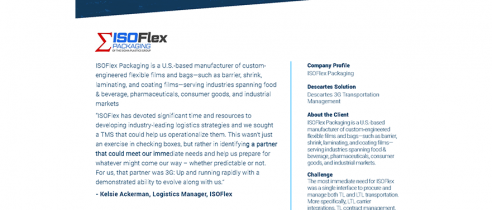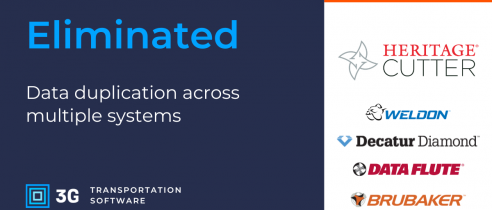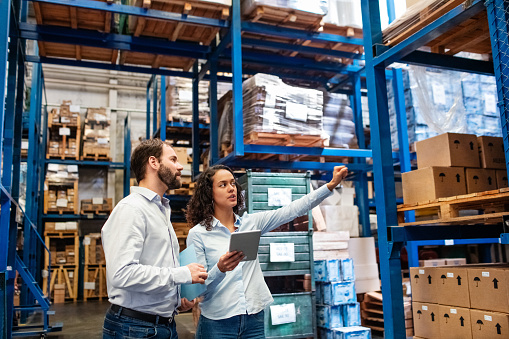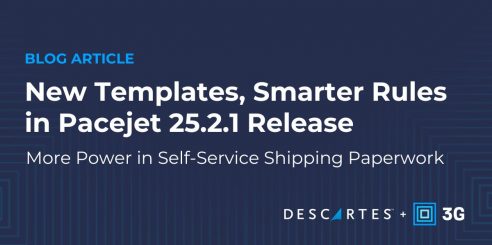Over the years, industries like e-commerce have steadily gained their place globally. The internet and technological advancements made it possible to buy and sell goods online, catering to approximately 5.3 billion internet users worldwide and counting. Behind the convenience of ordering goods online is warehousing, which helps facilitate the manufacture, import, export, and transfer of goods to your part of the world.
Business owners or logistics managers who sell physical goods aim to ensure the supply chain process runs smoothly. One solution is effective warehouse management and using 3PL (third-party logistics) with a 3PL warehouse management system.
While this strategy is good for business owners, third-party logistics companies face challenges. Warehouse capacity, workforce, employee safety, shipping cost, and technology are the top concerns of 3PL providers. Third-party logistics operations must continue evolving within all supply chain management aspects to stay competitive.
The Role of 3PL Warehouse Software
There are two main reasons why third-party logistics providers use third-party logistics software in their warehouses. The first is to ensure the efficiency of their services through digitalization, and the second is to improve their customer service by catering to the demands of their customers quickly and accurately.
During the pandemic, we saw the e-commerce industry boom, and with it came enormous demands from consumers. This boom also pushed 3PL providers to improve their processes to minimize the risk of error and ensure that products are delivered accurately when and where they need them.
Here are some key features and functionalities if you want to upgrade your system or know more about 3PL warehouse software.
Key Features and Functionality
Streamlining incoming process
- Advance shipment notification (ASN) creation
- Goods receipt
- Automatic or manual bin assignment
- Putaway using a mobile application
- Temperature zones assignment
- Catchweight-ready
Optimized order fulfillment
- Create delivery
- User-controlled wave picking
- Route-based picking
- Configurable stock allocation (FEFO, LIFO, etc.)
- Picking using a mobile app
- Shelf-life-driven order fulfillment
Better user control in dispatch management
- Group deliveries into pickups
- Order verification before dispatch
- Loading goods and items
- User-controlled loading bay management
Manage inventory
- Create scope of physical inventory
- System-generated counts
- Perform counting using a mobile app
- Review and reconcile inventory differences
- Cycle and blind counting ready
Smart packing and shipping processes
- Implement multi-level and qualified packing
- Create smart consignments and consolidate delivery notes into one consignment
- Print shipping notifications and documents
- Connect with 250+ carriers out of the box
- Print shipping labels and generate EDI messages and loading lists
Addressing common warehouse management challenges
Warehouse space or capacity
According to statistics, 80% of respondents from 3PL providers said that capacity is at the top of the list for warehouse management challenges. This is only natural because warehouses and distribution centers are only built based on the business’s needs during construction. Two more reasons for this are the rapid growth of the industry and the price hikes in real estate, which make it hard for warehouses and distribution centers to expand quickly.
To maximize the space of warehouses, 3PLs are starting to consider expanding vertically instead of horizontally. Using customized storage solutions like industrial shelving or pallet racks, warehouses can easily store added items without expanding. It is also helpful to know the layout of the warehouse and use materials that fit the space to improve the 3PL capacity and efficiency.
Lack of skilled labor and labor cost
Next to warehouse capacity, finding, retaining, and training qualified labor is the next big challenge when it comes to warehouse management. This is the effect of the sudden growth in logistics. Companies are expanding, so adding more personnel across job posts is necessary.
The issue then starts when companies need help finding qualified and capable employees to train and stay with them. In turn, businesses need to hire more workers, resulting in higher labor costs, slower business growth, and substandard services that can ruin the company’s reputation.
To solve this, businesses need to find a way to increase the productivity of their staff by improving how the warehouse is organized. It is tied up with maximizing storage space, and by doing this, businesses can reduce the time needed to search for a product. Automation can also help speed up looking for items when the warehouse is understaffed.
Employee safety
Warehouses can be a risky work environment. Accidents can sometimes happen, and they can injure personnel and damage goods. The issue here is not just about safety but also the consequences that stem from it. The company can lose money paying for medical bills, paying for and replacing damaged products, and dealing with the disrupted warehouse operations.
Reducing accidents and ensuring the safety of the employees means conducting safety training, providing constant reminders of the protocols, and providing personal protective equipment (PPE) for the staff. Aside from the human aspect, regular equipment maintenance should be conducted. An added precaution is to have regular safety audits to identify potential hazards.
Fluctuating demands
Dealing with the fluctuating demands of the market is one of the biggest challenges that warehouse managers face. Consistent orders keep the business running, but even though the boom of the e-commerce industry has helped bring in revenue, 3PL providers have to deal with seasonal demands.
Seasonal demands mean that some products have a higher demand depending on the time of year. 3PL providers are responsible for anticipating when a particular product will have outpouring demand. This foresight is essential because it allows them to get enough inventory when needed or know where to store them when the time comes.
One of the best ways to prepare for this challenge is to conduct market demand research and follow trends, especially for in-demand products. You should also contact your clients to discuss updates and exchange notes about current demands.
Technology
Through the years, technology has become a leading player in improving people’s and businesses’ lives. Faster production, efficiency, and data accuracy are the only ways technology has been helpful in logistics, manufacturing, and e-commerce.
More and more people develop new and more advanced technology, and the need to adapt to better systems cannot be ignored. This also applies to 3PL warehouse management. It is a costly investment, but with the right software, you can easily apply customizations and reap the benefits of updating your system to address the company’s needs.
Choosing the best 3PL warehouse software for the business is a matter of choice. A thorough understanding of their processes is required so that all of the features and functionalities of the software can be effectively implemented. Failing to choose a system that would fit the requirements and needs of the company would only result in wasted technology and high costs.
Benefits of 3PL Warehouse Software
The seamless operation of a warehouse seems easy, but there are many moving parts. It is a complicated business, mainly dealing with large volumes and thousands of products. 3PL warehouse software is a fulfillment solution that replaces outdated and manual tools that may not work.
Businesses across all industries have realized the benefits of using 3PL warehouse software in warehouse management, supply chain logistics, and business growth.
Scaling and growing business operations
In all businesses, time equates to money. Any downtime in your system is a missed opportunity for the business. The right 3PL warehouse software makes it easy for you to implement and update when you need to. E-commerce, or online shopping alone, is slated to reach about $8.1 trillion by 2026; it is better to anticipate this growth and be prepared to expand your operations in the future.
Cloud-based 3PL warehouse software programs allow you to update and customize your system with just a click, even without knowing how to code. Labor efficiency can also be increased by 40%, speeding up operations.
This convenience will give you more time to focus on time-sensitive tasks and other concerns that need attention.
Improved Inventory Management
Streamlining and simplifying your process is one of the aims of 3PL warehouse software. It also gives you the ability to access updated stock-related data and share it with people who are authorized to see it. Connecting the software with your shipping provider gives instant and real-time data like order status and stock levels.
Added features like producing advance shipping notifications for pick or pack demand, securing login details for your clients, and removing additional labor for creating and consolidating reports can also be possible when your 3PL warehouse software is paired with enterprise resource planning (ERP).
As a 3PL provider, imagine giving your customers a great experience with every transaction. Real-time delivery reports and updates for customers add to a positive customer experience.
Cost Reduction
There’s a reason why it’s essential to do things right the first time, all the time, especially in businesses. Any mistake is tied up with the cost, whether as simple as missing a delivery or an over or underweight in inventory.
75% of shippers reported that using 3PL services has contributed to overall logistics cost reductions. With businesses starting to trust 3PL providers more and more, they should be able to deliver reliable services to be competitive.
A 3PL management software can help maximize and optimize the use of storage space through warehouse space calculations. Automating the warehouse workflow accomplishes tasks faster with minimal human intervention, which means accuracy and efficiency even with only a few personnel.
Selecting the Right 3PL Warehouse Software
Being clear on the benefits and what a 3PL warehouse software can bring to your business brings us to the question of “How to choose the right 3PL warehouse software?”
Factors to consider in software evaluation
There are multiple 3PL management software you can choose from, but what’s important is to pick the one that suits your needs the most. Below are nine key factors that you should consider asking for when looking for 3PL software.
- Easy Onboarding Process
- Integration
- Functions for scalability
- Advanced billing and report generation
- Login portal for clients
- Configuration or customizability
- Multi-client management
- Specialized inventory control functionality and tracking
- Customer support
To make your decision-making more manageable, here’s a checklist from Veracore where you can conduct a primary assessment of your needs based on the nine critical factors mentioned above.
Future Trends in 3PL Warehouse Software
Adapting to future trends is good, but knowing the technology your competitors are adapting to can give you an idea of whether you need to keep up with these trends or wait it out. This lets you look at your business and see where it stands versus other 3PL providers.
Integration with emerging technologies
You can integrate different technologies with your 3PL warehouse management software. These technologies can give you an edge in the evolving 3PL warehouse management landscape.
Augmented Reality (AR)
AR can be advantageous for your personnel when looking for the best routes around the warehouse and accessing real-time information about inventory status.
Virtual Reality (VR)
VR can be used for employee training and the onboarding process. The business can add a module where the staff can practice their skills in a virtual environment, which will help speed up the learning curve.
Delivery Drones
Drones are not limited to surveillance anymore; they can also be utilized in deliveries. Drones can provide faster delivery, particularly to traffic-congested or hard-to-reach areas.
As mentioned earlier, adapting to these emerging technologies is based on whether there is a need for the business to integrate them.
Final Thoughts
The use of 3PL WMS eases warehouse management pain points. The issues this software addresses give you a better opportunity to fine-tune your system and focus on tasks like planning and forecasting so you can be prepared for the coming months or years.
Third-party logistics services are becoming more competitive and in demand. An upgrade of your 3PL warehouse software might be a good idea if the business is growing rapidly, as it could only mean better service for your customers and higher revenue.








